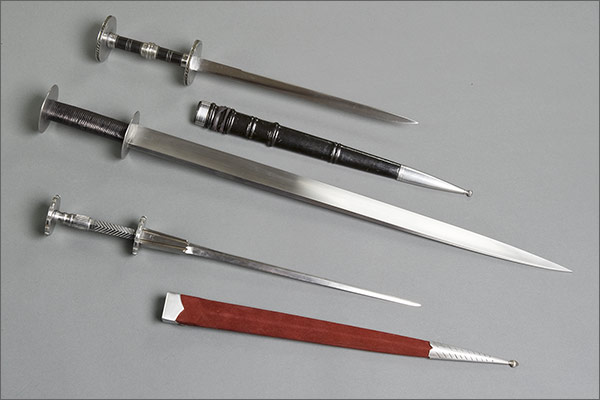There is a lot of talk about knife fighting. As traditional martial artists (we are following old-tyme martial arts) we often get captivated by the techniques. I know I do. But lets not lose the forest for the trees.
Knives are dangerous. We all say that, but do we know it? Do you know what it is to be cut, and see yours, or some one else's blood? I hope you do not. That knowledge is never gained in a positive way.
So, we are dealing with a knife. what do those look like. Well, Fiore used a pretty big knife, but a wide variety of other forms existed at that point in history, as well as now. We need to be prepared against all of them.
 |
| Rondel Daggers |
 |
| Modern Problem Knife |
So, how do knives hurt us? They cut or stab. In Medieval times, the thrust was considered more dangerous, as it entered into the body and damaged bits they had no technology to heal. Also, cuts can be superficial, and are less likely to penetrate clothing. As such, they can be less reliable.
 |
| Target color: Red from overhand, Blue from underhand, and purple for overlapping zone |
So,
- Cuts to unprotected areas.
- Stabs/Thrusts to any where.
- (Pommel strikes with big knives may also be a factor, but you deal with them them same, so let's not worry over them).
So, what do these attacks look like?
I have watched many, many hours of CCTV knife attacks in order to study this. It seems that stabbing attacks are still more common than slashing attacks. Both tend to originate from a draw or a place of concealment. Cuts tend to be pretty big and a little wild. Thrusts will come hard and repeatedly. Also, most attacks are accompanied by the attacker attaching to the target with his free hand.
It turns out that this is not very different from Fiore's day. Fiore suggests that overhand attacks will land some where in the lower head / upper chest of the victim, and that under handed attacks will land some where between the groin and the heart. His advice seems to hold true even to this day. (see chart)
The final thing to consider, both then and now, is that the knife is gonna be coming in pretty hard. This will not be a duel. In the medieval times, the knife was prohibited from friendly deeds or arms, but not the duel to the death. This will not be a cold and dispassionate attack, it will be an amped-up, last ditch attack from a desperate swordsman who's first lines of defense are down. Modern assailants are more likely on the predatory end of things but they still are emotionally charged, and their thrust(s)will come in with as much power as they can muster.
So, to recap:
1. We know the attack will come from close range, and with little warning.
2. We can Roughly judge, based on grip, where the strike will come (assuming we see the knife before the strike)
3. It will hit us HARD, and often repeatedly. The Agent wants us DEAD.
Keep these things in your mind while you train.
To that end, train at multiple power output levels, and train against good attacks.
- Aim for your target.
- Use well formed, direct attacks.
- Have attacker begin from both a ready position and the draw. you need to understand both.
OK, so next week we'll start looking the various rememdies, and how we can train them to work well for us.
Cheers,
J
Can't wait to read the next one!
ReplyDelete